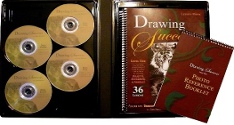Drawing Success with Jan Bower: Level I teaches drawing techniques appropriate for teens and adults. I think some middle school students might also enjoy this course and find it very manageable. The course teaches essential drawing skills, working simply with a sketch pencil and a charcoal pencil. While students begin by drawing circles and learning how to hold the pencil correctly, the course progresses from drawing various objects to drawing landscapes, birds, and animals. Students learn how to create accurate, detailed drawings using numerous techniques for realistic effects.
The course includes ten DVDs, a Lesson Book, and a Photo Reference Book, all of which come packaged together in a vinyl case. Supplies needed are minimal compared to some other art courses: a table or working surface with suitable light and elbow space, light-colored backdrop to use for still-life drawing, a directional light, a sketchpad , newsprint or copy paper, a 6B sketch pencil, a charcoal pencil, pencil sharpener, kneaded eraser, an erasing shield, a ruler, paper stumps, and fixative.
Teacher Jan Bower helps students establish proper techniques from the beginning as she demonstrates step-by-step with lots of explanation in the DVD lessons. Videos were filmed with multiple cameras so that students can view Bower’s work from different angles and distances, and the video lessons run from 23 to 56 minutes each. Bower makes the process easy for beginners. She reminds students to pause the video or review whenever they need to. Her calm tone of voice is very reassuring and encouraging. Background music that plays from time to time is a charming, lilting melody.
Bower adds occasional Christian commentary, and scripture verses are included throughout the Lesson Book and on the videos. While Bower's Christian viewpoint is not so visible at the beginning of the course, it becomes more so as the lessons progress.
The Lesson Book briefly summarizes and illustrates the key elements of each lesson, but it essentially repeats what’s on the video. While students are likely to use the Lesson Book as a reference—most likely to look at the sample illustrations—the DVD lessons are the main event. Although it isn’t the primary source of lesson material, the Lesson Book is still essential. Students will use it to study the images, write notes, quickly review the main points of a lesson, answer chapter review questions, and look up words in the glossary.
Students begin by drawing spheres and continue with other three-dimensional objects—cylinders, cubes, and cones—in the second lesson because the goal is to learn to draw things as they really appear from the very beginning. Students then use approximations of the four basic shapes as they draw real items such as a perfume bottle, a teddy bear, and an oil lamp. Lessons gradually add techniques. Bower uses an interesting strategy of having students begin a drawing by applying only techniques learned thus far, then revisiting the same drawing using additional techniques to gradually complete the drawing. For example, students begin drawing a jewelry box in the second lesson. They revisit the jewelry box for further work in lesson four and complete it in lesson nine. This same learning strategy is applied to a number of drawing projects, especially early in the course. By the end of the course, students are drawing animals and landscapes.
The lessons systematically develop skills, continually building upon skills previously taught, even when the subject matter changes. Students practice new techniques as they first work on newsprint then repeat the exercise in their sketchbook when they are confident of what they are doing.
Students will sometimes be directed to set up their own still life object or group of objects for an exercise, but the Photo Reference Book has high-resolution images that students can use instead. The Photo Reference Book also has images that will be used on their own for some lessons.
There are 36 lessons in the courses, and lessons are grouped into an introduction and eight chapters. Each chapter has from two to eight lessons, but many lessons have multiple parts. Younger students might tackle only one part of a lesson on a single day, while older students might work through more than one part of a lesson. Most chapters conclude with a review page of questions for students to answer. It is difficult to predict how long it might take to complete the course. I expect that teens and adults will easily be able to complete it in one year or less, but if you try it with younger students you might take longer.
The course can be used independently by self-directed students, while others might study under the direction of a parent or as part of a group class. Since Bower, does the teaching, a parent or class facilitator can learn right along with the students.
I really like the way this course builds skills sequentially. Students should really learn how to produce very skillful and impressive artwork as they progress through the lessons. By teaching incrementally, Bower makes it possible for every student to be successful, even adults who think they have no drawing talent.









